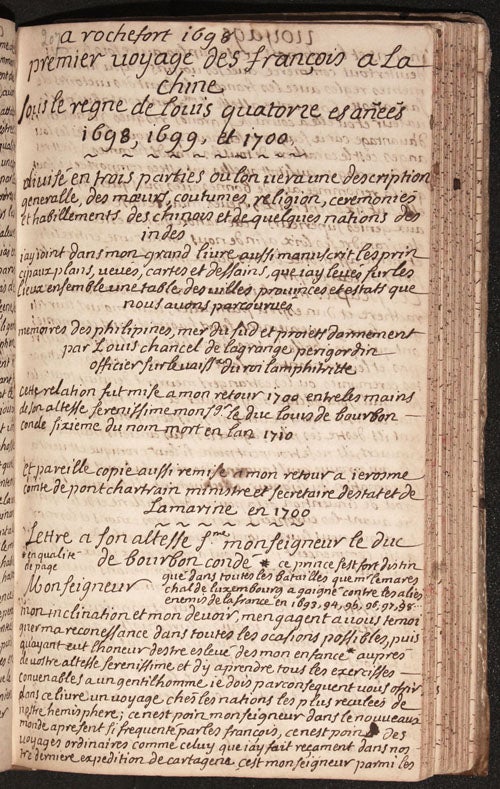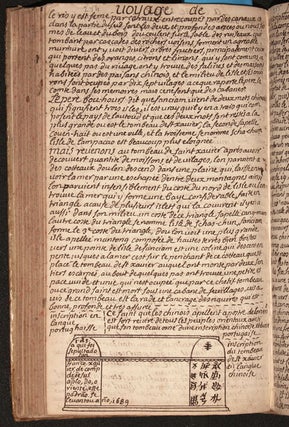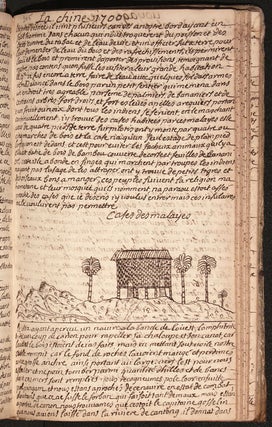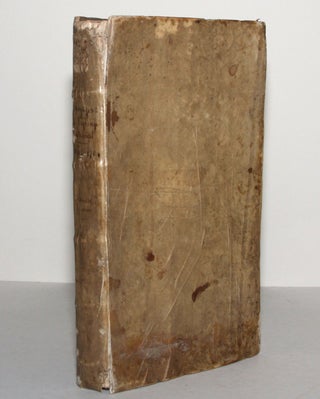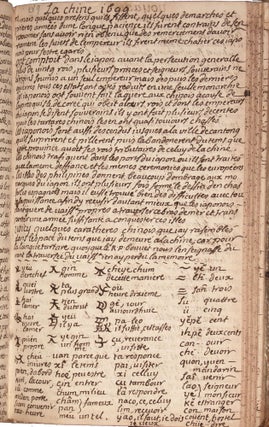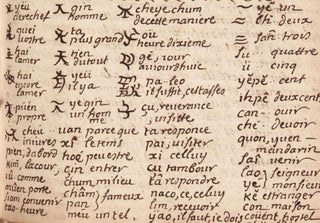Le premier volume des voyages curieux faits dans diverses provinces, de France, dEspagne, de Flandres et de Loraine lespace de cinquante ans par mess.re Louis de Chancel de Lagrange ... escrit de sa propre main.
4to [297 x 173 mm], Manuscript on paper, (2) pp., 384 pp, (4) pp. Bound in contemporary vellum over boards, manuscript title on spine, remnants of ties, red sprinkled edges. Some joint separation at head and tail of upper cover, minor rubbing, some staining and scoring to the covers. Narrow margins with edge occasionally touching a letter but with no loss of text, a few minor stains, otherwise excellently preserved and perfectly legible throughout.
Unpublished autograph manuscript by the French nobleman and traveller Louis de Chancel de Lagrange (1678-1747) documenting his extraordinary world travels between 1692 and 1704. Lagrange provides an eyewitness account of the groundbreaking 1698-1700 trading expedition to Canton made by the frigate L’Amphitrite, considered the “the first voyage of the French to China” (p. 207; see also Lach and Van Kley, p. 104), as well as first-hand information concerning Louis XIV’s various military campaigns during the Nine Years’ War (1688-1697), including accounts of the Siege of Namur (1692) and the Raid on Cartagena (1697). Over the nearly 400 closely written pages of his manuscript Lagrange also provides insider knowledge on current politics, court intrigue, and the like, all the while carefully describing the architecture, natural setting, and inhabitants of the some 200 towns and cities he visited in Europe, the Americas, Africa, and Asia.
Lagrange, a native of Périgueux, begins his manuscript with an account of his early childhood, noting that unlike his older brother, François Joseph Lagrange-Chancel (1677-1758), the child-prodigy dramatist once thought to be the next Racine, he struggled with formal education, preferring to make paper boats over reading books and drafting essays (p. 1). Sent to Paris at the age of twelve to serve as a page in the household of Marie Anne de Bourbon, daughter of Louis XIV and his mistress Louise de La Vallière, Lagrange soon lost his “Gascogne accent” (p. 5) and was tutored under the finest masters of mathematics, geography, science, drawing and dance. Not yet sixteen years old, Lagrange joined the navy in 1694, taking part in Louis XIV’s Catalonia campaign (1694), battling Spain in the Azores (1696), and in the West Indies privateering at the Siege of Cartagena (1697), with the latter engagement extensively described (pp. 119-151) both in terms of military matters and of the layout, inhabitants and customs of the city itself (Saint-Domingue and Havana are also discussed).
However, it is the famous 1698-1700 voyage of the Amphitrite to China that occupies the longest section of the manuscript (pp. 207-315). Jesuit missionaries had operated in China for some time, and it was one of these – Joachim Bouvet (1656-1730) – who encouraged greater French participation in the region after the Kangxi Emperor’s 1692 Edict of Toleration and the opening of Canton to all Western nations. The Compagnie des Indes Orientales, founded in 1664, had never traded in China, but with the permission of Jérôme Phélypeaux, Comte de Pontchartrain, Minister of the Navy (1674-1747), the Company formed a loose alliance with the wealthy Marseille merchant Jean Jourdan, who purchased the Amphitrite from Louis XIV (Jourdan would found the Compagnie de la Chine at the ship’s return in 1700). The voyage, operating under the vaguely defined ‘Société de Jourdan’, was at once a commercial venture, a missionary project (several Jesuits were aboard), and a semi-official cultural exchange, with the precise status of the Amphitrite disputed even among the Chinese, who sometimes took the frigate to be a merchant ship, sometimes a royal embassy (see, Madrolle, esp. pp. xxi-lxxxi).
Serving as a junior officer, Lagrange describes the locales and peoples he observed en route to Canton, including Robben Island and the Cape of Good Hope (pp. 220-9), Ache, Malacca, Bantan, and Macau. He mentions the navigational difficulties encountered by the French, who at the time had a poor understanding of Asian geography (p. 211; L’Amphitrite narrowly avoided running aground on one occasion). Lagrange visits the first burial site of St. Francis Xavier (1506-52), on Sangchuan Island, and provides a drawing of the tomb with its Portuguese and Chinese inscriptions (p. 253-5). Attention is given to the broader cultural achievements of the Chinese (their great antiquity, their invention of printing and gun powder, etc.) and to the commercial potential of French-Chinese trade: Under the heading “Goods exported from Europe to China, and those imported into France from China” (p. 283) Lagrange discusses such merchandise as mirrors, corals, silk fabrics, porcelain, lacquered furniture, paper, and ink. He provides information on Chinese language (a glossary of useful terms in both Chinese characters and phonetic spelling is provided at p. 289), on the appearance and dress of both men and women of various classes, temples and religious ceremonies, politics, theater, food and dining customs, boats and ships, wine and fruit, weights and measures, money, Jesuit activities in China, the brutality of the Chinese police force, the human trafficking of the Chinese by the Japanese, the Emperor’s ban on French music, and a particularly violent tropical storm he encountered (tiphon ou houragan furieux). Lagrange also reports on the activities of his European shipmates, including the “excellent painter” Giovanni Gherardini (c. 1655-1723), who executed portraits of the royal family and the imperial court, “even women, contrary to the usual custom” (pp. 215, 292). “The Admiration the Chinese paid to him was not only due to his astonishing mastery of perspective, but also for introducing the technique of oil painting into China, both of which were then unknown in that country” (Western Travellers, p. 59).
Lagrange also describes his overland trips trailing the movement of Louis XIV’s court across France and the Low Countries and adds to these youthful narratives further observations made later in life. He describes the riches of Chantilly, Versailles, Marly, and Meudon, as well as the landmarks of scores of smaller towns and villages rarely treated in early travel narratives (e.g., Senlis, Compiegne, Maubeuge, Beaumont, Philippeville, Charlemont, Mariembourg, Rocroi, Charleville, Rethel, Dammartin, etc.). Lagrange gives considerable attention to Paris proper, describing not only its cathedrals and picture galleries, but also the (sometimes seedy) neighborhoods around Saint-Germain and Saint-Laurent, with their comic operas, theaters, rope dances, animal combat, giants & dwarves, marionettes, games of chance, and abundant (some 250) cafes (p. 67).
Describing himself as being “almost 70 years old” (p. 3), Lagrange apparently wrote out the present manuscript in 1743 (“mais auiourdhuic que iescris 1743,” p. 192) for his personal use (“iescris pour moi,” p. 2). This volume was known to the scholar Paul Pelliot, who mentions in his series of articles on the voyage of the Amphitrite (published in 1929-30) that the manuscript was then in the possession of the naval officer Georges du Loup (Pelliot, p. 443). Lagrange notes that he wrote a second volume covering his travels after 1704, but this was not in the possession of Du Loup, was unknown to Pelliot, and is still untraced. Lagrange mentions that in 1740 he presented in Bayonne a deluxe illustrated manuscript of his voyages to Don Philip of Spain (1720-65), spouse of Louise Élisabeth of France, eldest daughter of Louis XIV. This volume is also untraced today. Furthermore, Lagrange records that in 1700 he gave versions of his China voyage account to Louis de Bourbon (1668-1710) and to Jérôme Phélypeaux, Comte de Pontchartrain, Minister of the Navy (1674-1747); neither manuscript is known today (see Pelliot, especially p. 441-7). Lagrange also laments that two volumes of his China notebooks were lost in the 1712 shipwreck of the Magnanime and the Fidelle in the Azores (his younger brother, who had been reading the account, perished in the wreck along with 400 sailors).
* Paul Pelliot, “L’origine des relations de la France et de la Chine: Premier voyage de ‘l’Amphitrite’ en Chine,” Journal de savants, (1928) pp. 433-51 and (1929) pp. 110-25, 252-67, and 289-98; E. W. Dahlgren, Les relations commerciales et maritimes entre la France et les côtes de l’océan Pacifique; D. F. Lach and E. J. Van Kley, Asia in the Making of Europe, vol. III, book I; C. Madrolle, Les premiers voyages Français à la Chine: La Compagnie de la Chine (1698-1719); Western Travellers in China: Discovering the Middle Kingdom (Brussels: Bibliotheca Wittockiana, 2009).
Sold

